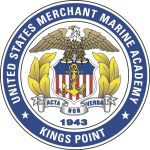News
USMMA Key Component in Addressing Maritime Security Challenges
The ruling Chinese Communist Party is placing a premium on sea power and is well on its way to building a fleet rivaling the American Navy. One of the most damning points made in CNN’s report is that just one of China’s 13 shipyards has “more capacity than all our shipyards combined.”
We are not building enough ships, but I am hopeful that Congress understands this existential threat and will act accordingly.
Of course, maritime power is not achieved by ship count alone; a vessel – be it a USN aircraft carrier or the commercial tanker that refuels it – is only as good as the people behind it, and we must remember – as history repeatedly tell us – that merchant mariners are the key to victory in any protracted conflict.
Most warfighting equipment is moved by commercial vessels, commanded and crewed by highly trained, licensed merchant mariners who comprise the Strategic Sealift Officer (SSO) Force. Over 80% of these service-obligated SSOs are graduates of the U.S. Merchant Marine Academy (USMMA).
As America readies itself for unprecedented challenges from the likes of China, we need to remember its not all about hardware. We need the right people with the right training, who are ready, able, and willing to serve their country. For military sealift, that’s where the USMMA comes in.
USMMA is the only federal service academy that educates and graduates the licensed Merchant Marine officers needed to execute military sealifts. USMMA is also the only maritime school in which 100 percent of graduates both earn a Merchant Marine license and incur a mandatory obligation to serve their country for eight years.
Graduates of the United States Merchant Marine Academy (USMMA) are vital to the operation of military sealift in times of conflict and national emergency. Without a comprehensive capital improvement plan and timely execution moving forward, USMMA will continue to deteriorate –adversely impacting the recruitment of dedicated service-obligated midshipmen as well as the education and training delivered by this critical Federal institution.
USMMA graduates – all militarily obligated – make up over 80 percent of the U.S. Navy’s Strategic Sealift Officer Force. Without them, the nation would have no viable – or reliable – means of manning vessels that move weapons, troops, fuel, and supplies in wartime.
USMMA’s campus remains largely unchanged from its founding 80 years ago. Beyond deteriorating buildings, the library, IT capacity, training labs, and physical readiness resources are woefully inadequate and shockingly subpar when compared to other federal service academies.
While maritime technology has moved at breakneck speed, midshipmen learn, train, and study in antiquated facilities that hinder the Academy’s ability to educate and train to current standards. A 2021 report by the National Academy of Public Administration warned that “poor physical conditions on campus interfere with learning and the student experience”.
